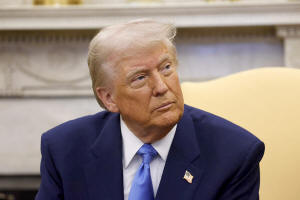Trump says Canada and Mexico tariffs are 'going forward' with more
import taxes to come
 Send a link to a friend
Send a link to a friend
 [February 25, 2025]
By JOSH BOAK and FABIOLA SANCHEZ [February 25, 2025]
By JOSH BOAK and FABIOLA SANCHEZ
WASHINGTON (AP) — President Donald Trump said Monday that his tariffs on
Canada and Mexico are starting next month, ending a monthlong suspension
on the planned import taxes that could potentially hurt economic growth
and worsen inflation.
“We’re on time with the tariffs, and it seems like that’s moving along
very rapidly,” the U.S. president said at a White House news conference
with French President Emmanuel Macron.
While Trump was answering a specific question about the taxes to be
charged on America's two largest trading partners, the U.S. president
also stressed more broadly that his intended “reciprocal” tariffs were
on schedule to begin as soon as April.
“The tariffs are going forward on time, on schedule,” Trump said.
Trump has claimed that other countries charge unfair import taxes that
have come at the expense of domestic manufacturing and jobs. His near
constant threats of tariffs have already raised concerns among
businesses and consumers about an economic slowdown and accelerating
inflation. But Trump claims that the import taxes would ultimately
generate revenues to reduce the federal budget deficit and new jobs for
workers.
“Our country will be extremely liquid and rich again,” Trump said.

In a interview with Fox News late Monday, Macron said he hoped he had
convinced Trump to avoid a possible trade war, noting the difficulty of
taking on a traditional ally such as Europe while simultaneously using
tariffs to challenge China's industrial might.
“We don’t need a trade war," Marcon said. "We need more prosperity
together.”
Most economists say the cost of the taxes could largely be borne by
consumers, retailers and manufacturers such as auto companies that
source globally and rely on raw materials such as steel and aluminum
that Trump is already, separately, tariffing at 25%.
Still, Mexican President Claudia Sheinbaum appeared confident Monday
that her administration would reach agreements with the U.S. government
before the deadline set by Trump.
“We would need to be reaching important agreements this Friday,”
Sheinbaum told reporters Monday morning before Trump's remarks. “On all
of the issues there is communication and what we need is to complete
this agreement, I believe we’re in a place to do it.”
If necessary, she said she would seek to speak directly with Trump
again. In high-level discussions between both governments, Mexico has
insisted that the U.S. also take a hard look at the drug distribution
and consumption in its own country rather than pointing only at
production in Mexico, Sheinbaum said.
Companies like Walmart have warned about uncertainty, while the
University of Michigan's latest consumer sentiment index plunged by
roughly 10% over the past month in part due to fears about tariffs and
inflation worsening. In the 2024 presidential election, voters backed
Trump on the belief that he could cool inflation that had spiked to a
four-decade high in the aftermath of the coronavirus pandemic during
President Joe Biden's time in office.
[to top of second column]
|

President Donald Trump listens during a meeting with France's
President Emmanuel Macron in the Oval Office of the White House in
Washington, Monday, Feb. 24, 2025. (Ludovic Marin/Pool via AP)

But Trump has persistently threatened tariffs and kept up those
calls even as Macron, standing beside him, had previously suggested
that talks on trade had produced some common ground.
“We want to make a sincere commitment towards a fair competition
where we have smooth trade and more investments,” Macron said at the
news conference, according to a translation of his French remarks.
Macron said the idea is to help the U.S. and Europe both prosper,
saying that further talks would be carried out by their respective
teams to flesh out their ideas.
Investors, businesses and the broader public are still trying to
determine whether Trump is merely threatening tariffs as a
negotiating tool or if he sincerely backs the tax hikes as a way to
offset his planned income tax cuts.
Despite talks the Trump administration has held with Canadian and
Mexican officials, the U.S. president signaled Monday that he would
end the 30-day suspension of tariffs that were initially set to take
effect in February. Trump plans to tax imports from Mexico at 25% as
well as most goods from Canada, with energy products such as
Canadian oil and electricity being tariffed at a lower 10%.
Trump is placing tariffs on Canadian and Mexican goods with the
stated goal of pressuring them to do more to address illegal
immigration and the smuggling of illicit drugs such as fentanyl.
While relatively little fentanyl comes from Canada, the country
announced a czar to address the issue and appease Trump in addition
to existing measures. Mexico has relocated 10,000 members of its
National Guard to the border with the United States in addition to
existing measures.
Trump also plans to impose new tariffs to match the rates charged by
other countries. Set to begin as soon as April, the tariffs could be
higher than what other countries would charge as subsidies,
regulatory barriers and the value added tax — which is akin to a
sales tax common in Europe — would be included in the calculations.

The possibility of retaliatory tariffs planned by Canada, Mexico and
Europe could lead to a broader trade conflict that sabotage growth.
In February, the Yale University Budget Lab estimated that the
Canadian and Mexican tariffs could depress average U.S. incomes by
$1,170 to $1,245 a year.
__
Sanchez contributed reporting from Mexico City.
All contents © copyright 2025 Associated Press. All rights reserved |